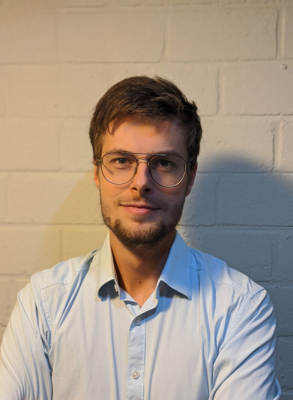Monodisperse Microbubble Production and Characterization for Medical Applications
Martin van den Broek is a PhD student in the department Biomedical and Environmental Sensorsystems. (Co)Promotors are prof.dr.ir. A. van den Berg; and dr. T.J. Segers from the faculty of Electrical Engineering, Mathematics and Computer Science and prof.dr. M. Versluis from the faculty of Sciences & Technology.
 Microbubbles have potential beyond their current use as UCA because mi- crobubble dynamics are highly sensitive to their surroundings, including am- bient pressure and confinement. As such, microbubbles have been proposed as in-vivo sensors for pressure sensing and molecular imaging applications. Key to these emerging applications of microbubbles and ultrasound is control over microbubble dynamics. This dissertation focuses on developing methodologies and understanding allowing the design of microbubble suspensions tailored to enable emerging applications such as pressure sensing, molecular imaging, and controlled and safe sonoporation.
Microbubbles have potential beyond their current use as UCA because mi- crobubble dynamics are highly sensitive to their surroundings, including am- bient pressure and confinement. As such, microbubbles have been proposed as in-vivo sensors for pressure sensing and molecular imaging applications. Key to these emerging applications of microbubbles and ultrasound is control over microbubble dynamics. This dissertation focuses on developing methodologies and understanding allowing the design of microbubble suspensions tailored to enable emerging applications such as pressure sensing, molecular imaging, and controlled and safe sonoporation.
In Chapter 2, we develop a novel method for fast, controlled, and fully au- tomated removal of excess coating material from a microbubble suspension. Here, microbubbles are loaded into a microfluidic channel with a height of 1 mm and allowed to rise to the top. Clean medium is then pumped through the channel, flushing out excess lipids via convection and diffusion, while ridges at the inlet and outlet keep the bubbles contained within the channel. We demonstrate that this washing procedure can lower the excess lipid concentra- tion by 4 orders of magnitude while the bubble size distribution, functionality, and acoustic response remain unaffected.
In Chapter 3, we introduce optical attenuation spectroscopy (OAS) as a method for sizing monodisperse microbubble suspensions. In this method, the opti- cal attenuation at different wavelengths through a suspension of monodisperse microbubbles is measured using a photospectrometer. The size distribution is obtained by fitting a modeled optical attenuation spectrum calculated us- ing Mie theory to the experimental data. We found that the modal radius and polydispersity index (PDI) measured using OAS were in close agreement (within ±1.5%) with values obtained via fluorescence microscopy. However, comparisons with Coulter Counter measurements revealed a systematic over- estimation of microbubble size by the Coulter Counter.
In Chapter 4, we present a novel microbubble rheometry approach for high- precision, rapid measurements of microbubble dilatational shell properties. By combining acoustic attenuation spectroscopy with optical attenuation to track relative size changes in a monodisperse microbubble population within the same sample, dilatational shell rheology data can be obtained within min- utes. We demonstrate the potential of our microbubble interfacial rheometer by including data on the role of palmitic acid on shell rheology, the effect of medium salinity on shell rheology and the change in shell rheology with medium pH.
In Chapter 5, we investigate the influence of scaffold stiffness on sonoporation outcome using simultaneous ultra-high-speed imaging (10 million frames per second) to capture bubble dynamics and high-resolution confocal microscopy to assess cell membrane response and model drug uptake. Monodisperse mi- crobubbles are used to sonoporate single human umbilical vein endothelial cells (HUVECs) cultured on either a soft hydrogel scaffold or a rigid polystyrene membrane. We observed that, for a rigid scaffold, sonoporation efficiency sharply increased from 10% to 90% within a narrow radial excursion range of 0.1 µm beyond the sonoporation threshold. In contrast, when using a soft cell culture scaffold, the slope of the sonoporation efficiency–radial excursion curve was reduced by a factor of thirty compared to a rigid scaffold, despite no evident differences in microbubble dynamics. Furthermore, we observed nearly identical sonoporation efficiency curves across the employed ultrasound frequencies (0.5, 1.0, and 2.0 MHz) which suggests that acoustic radiation forces and normal or shear stresses are unlikely to be the primary mechanisms driving the observed differences. Instead, we proposed that cell membrane strain is reduced in the soft scaffold case due to the movement of the cell with the oscillating bubble.





